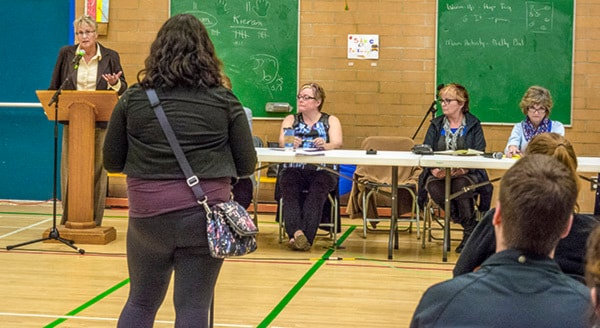A decision of the fate of local schools is expected in a little over a month, on Jan. 20.
Though the public consultation sessions are now finished, there is still time to register your opinion about the future of schools in the Okanagan-Skaha School District before the board of education begins deliberations.
“We still have our online survey and our email options open until Jan. 10 for anyone who wants to provide input for feedback that hasn’t done so already,” said school district superintendent Wendy Hyer.
That is the end, however, to public input unless the board decides it wants to gather information on a specific issue or plan.
“We are starting right on Jan. 1 and we are going to start digging into all the feedback,” said board chair Linda Van Alphen. “We will be in closed meetings and we’re going to be just weighing all the information that comes in. I believe there is going to be an overarching strategic plan for the whole district, which will come out of those nine options.”
Those options range from closing individual elementary schools to major reconfigurations that would see Penticton Secondary and KVR Middle School combined as a Grade 9-12 high school, with Skaha Lake Middle School and Princess Margaret becoming a Grade 6-8 middle school.
Van Alphen said that while these are difficult decisions for the board, she is looking forward to not having to deal with making cutbacks every year to meet the annual $1.2-million budget shortfall the district has experienced for several years.
“I am really looking forward to seeing how it turns out 10 years down the road,” said Van Alphen. “I have talked to a lot of other districts who have done this and they said it was the best thing they could have done.
Even though change is so hard on everyone, I think that if we can get ourselves into that good situation, then we are going to be able to concentrate on those programs that we have been talking about with all the parents.”
Both Van Alphen and Hyer said the meetings were well attended, and thought the feedback about changes was the most important outcome, but there are some other benefits.
“I think what happened more than anything is that people got to know our school district a lot better. Because we were able to talk about our international program, we were able to talk about the good programs that we have going in each one of the schools, with the parents at each one of those schools,” said Van Alphen. “We were also able to tell them that we can’t afford the system that we have anymore and that is was starving the programs.”
The board’s decision on the future configuration of Okanagan Skaha is expected on Jan. 20. Once that is made, Hyer said work will begin on how to make the changes. Those would take effect September 2016, or be spread out over a longer period.
“It depends where they are headed. Once they have made that decision, they are going to make sure staff can do a good job of implementing that decision,” said Hyer.
The feedback received at the public meetings will be helpful in that process too, she added.
“Through the whole process, we heard about the things they (parents and community members) value,” said Hyer. “If and when a decision is made, then it is district staff’s responsibility to pull those pieces out, and make sure what they value is maintained as we move forward.”
If the board chooses to close one or more schools, there are three options for what to do with it: it could be shuttered until it is needed again, which would come with a smaller, but ongoing maintenance cost; it could be leased to a third party; or the building and land could be sold.
Money coming through leasing school properties could go into operating budgets every year, as already happens with Ecole Entré Lac, but the third option would see three-quarters of the sale price taken by the provincial government and held in trust for future capital improvements in the school district.
“Later on we can apply to use those funds for a capital project. The other 25 per cent stays here, and we can use it for capital projects. But we can’t use it in the operating budget,” said Hyer.
